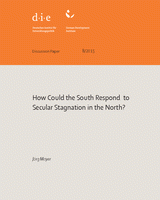How could the South respond to secular stagnation in the North?
Mayer, JörgDiscussion Paper 8/2015
Bonn: German Development Institute / Deutsches Institut für Entwicklungspolitik (DIE)
ISBN: 978-3-88985-672-2
Price: 6 €
Developed countries face the risk of a sustained lack of aggregate demand, i.e. secular stagnation. Demand-oriented growth models emphasizing the balance-of-payments constraint raise concerns about attendant adverse growth impacts on developing countries from reduced export growth. These concerns are well-founded, albeit less serious than the simplest versions of these models would imply. Relaxing their assumptions and emphasizing cumulative causation forces from domestic-demand growth and relative price effects indicates how developing countries can combine export and domestic demand-based strategies and how changed policies can maintain rapid growth while reducing the income elasticity of import demand. Crucial is investment that reduces gaps between the composition of domestic production and domestic demand and emphasizes sectors with cumulative-causation effects, combined with incomes policy and capital-account management. Drawing down excessive foreign-exchange reserves and obtaining concessionary loans from development banks can finance required capital-goods imports, especially in countries with insufficient innovation capacity. Enhanced South-South integration may be an important complement for small countries.

